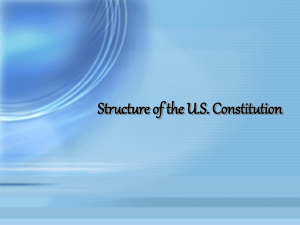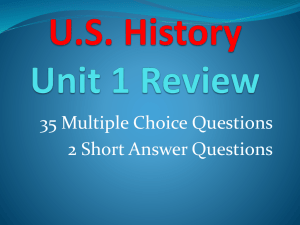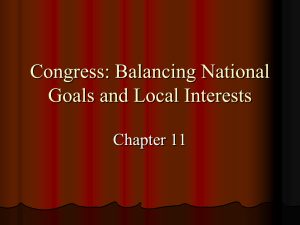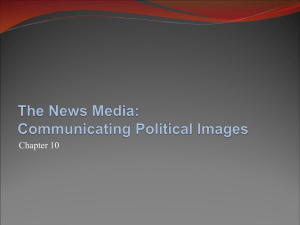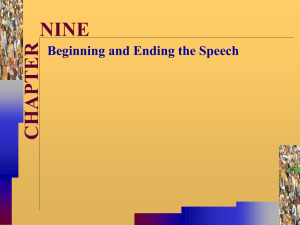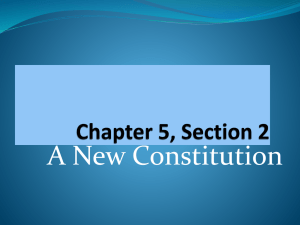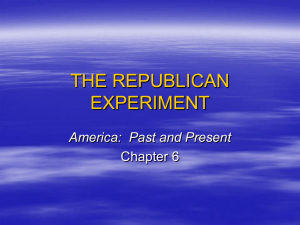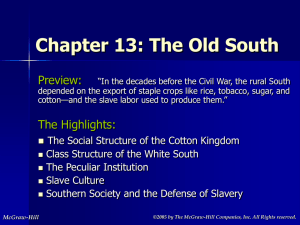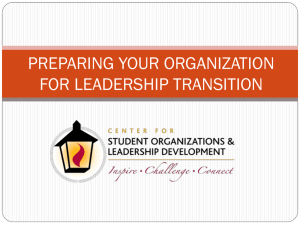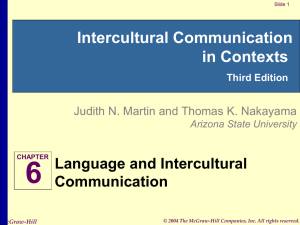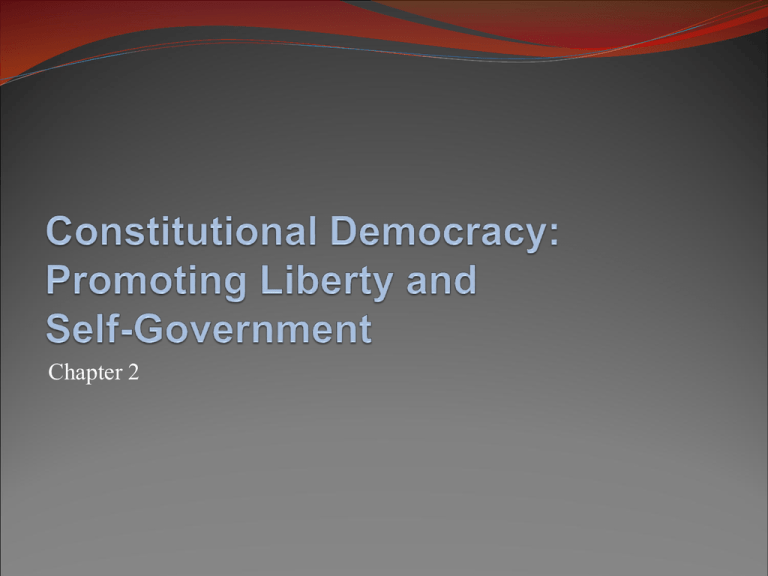
Chapter 2
Before the Constitution:
Colonial and Revolutionary Experiences
Before the Constitution
Colonial experiences with democratic institutions; English
Parliament and colonial charters
The “rights of Englishmen”—including trial by jury
Repeal of the Stamp Act: a tax on colonial newspapers and
document
Enactment of the Townsend Act: tax on tea
First Continental Congress
© 2014, McGraw-Hill Education. All Rights Reserved.
2
Before the Constitution:
Colonial and Revolutionary Experiences
Declaration of Independence
A call to revolution—liberty, equality, individual rights, selfgovernment, lawful powers
Philosophy of John Locke
Inalienable (natural) rights: life, liberty, and property
Social contract: government has responsibility to preserve rights
Thomas Jefferson
“All men are created equal”
Just powers derive from the consent of the governed
© 2014, McGraw-Hill Education. All Rights Reserved.
3
Before the Constitution:
Colonial and Revolutionary Experiences
Articles of Confederation
Adopted during the Revolutionary War
Created weak national government
States retained “sovereignty, freedom and independence”
Prohibited Congress from interfering in states’ commerce
policies
Prohibited Congress from taxation
© 2014, McGraw-Hill Education. All Rights Reserved.
4
Before the Constitution:
Colonial and Revolutionary Experiences
A nation dissolving
Raised fears about the weakness of the national government
Weakened Congress—nation dissolving
Farmers, led by Daniel Shays, marched to prevent
foreclosures on their land
Congress unable to raise army to quell rebellion
Motivated Congress to authorize a convention in
Philadelphia to revise Articles of Confederation
© 2014, McGraw-Hill Education. All Rights Reserved.
5
Negotiating toward a Constitution
The Great Compromise: a two-chamber Congress
Virginia (large-state) Plan
Representation based on population number
Greater power to larger states
New Jersey (small-state) Plan
Each state would have one vote
Equal power to large and small states
Great Compromise: two-chamber Congress
House of Representatives: proportional representation
Senate: equal representation
© 2014, McGraw-Hill Education. All Rights Reserved.
6
Negotiating toward a Constitution
The Three-Fifths Compromise: issues of slavery and trade
Congress agreed not to tax exports, only imports
Congress agreed not to outlaw slavery
Three-Fifths Compromise: three-fifths of enslaved
population counted for apportionment of taxes and political
representation
© 2014, McGraw-Hill Education. All Rights Reserved.
7
Insert Figure 2-1
African Americans as a Percentage of State Population, 1790
© 2014, McGraw-Hill Education. All Rights Reserved.
8
Negotiating toward a Constitution
A strategy for ratification
Constitution submitted directly to the states
Federalists: proponents of the Constitution
Anti-Federalists: against a strong national government
© 2014, McGraw-Hill Education. All Rights Reserved.
9
Negotiating toward a Constitution
The ratification debate
Anti-Federalists raised arguments that still echo in American
politics
The national government would be too powerful
State self-government and personal liberty at risk
The Federalist Papers: Alexander Hamilton,
James Madison, John Jay
© 2014, McGraw-Hill Education. All Rights Reserved.
10
Negotiating toward a Constitution
The framers’ goals
Government strong enough to meet the country’s needs
Government not threatening existence of the separate states
Government not threatening liberty
Government based on popular consent
© 2014, McGraw-Hill Education. All Rights Reserved.
11
Insert Table 2-1
Major Goals of the Framers of the Constitution
© 2014, McGraw-Hill Education. All Rights Reserved.
12
Protecting Liberty:
Limited Government
Grants and denials of power
Grants:
Limit government by stating specific powers in the Constitution
Total of seventeen powers
Denials:
Limit government by stating specific prohibitions in the
Constitution
Constitution difficult to amend
© 2014, McGraw-Hill Education. All Rights Reserved.
13
Protecting Liberty:
Limited Government
Using power to offset power
Montesquieu’s concept of separation of powers
Madison’s Federalist No. 10 and the problem of
overbearing majorities
The framers’ special contribution: separate but overlapping
powers
© 2014, McGraw-Hill Education. All Rights Reserved.
14
Insert Table 2-2
Constitutional Provisions for Limited Government
© 2014, McGraw-Hill Education. All Rights Reserved.
15
Protecting Liberty:
Limited Government
Separated institutions sharing power: checks and balances
Separation of powers: divide powers of government
Shared institutions—checks and balances
Shared legislative powers: Congress checked by the president,
Supreme Court
Shared executive powers: president checked by
Congress, Supreme Court
Shared judicial powers: courts checked by the president, Congress
© 2014, McGraw-Hill Education. All Rights Reserved.
16
Insert Figure 2-2
The System of Checks and Balances
© 2014, McGraw-Hill Education. All Rights Reserved.
17
Protecting Liberty:
Limited Government
Bill of Rights
First ten amendments to Constitution
Protects rights of citizens, such as:
Freedom of speech
Trial by jury of peers, and legal counsel
Freedom of religion
Limits power of government
© 2014, McGraw-Hill Education. All Rights Reserved.
18
Protecting Liberty:
Limited Government
Judicial review
Courts determine if governmental institution is acting within
its constitutional powers
Established by Chief Justice John Marshall in Marbury v.
Madison (1803)
© 2014, McGraw-Hill Education. All Rights Reserved.
19
Providing for Self-Government
Democracy versus republic
Framers feared the overbearing power of the majority in a
democracy
Framers preferred concept of a republic, where people rule
through elected representatives
Majority rule in a republic is limited to protect minority
rights
© 2014, McGraw-Hill Education. All Rights Reserved.
20
Providing for Self-Government
Limited popular rule
People participate indirectly in process of government
through election of officials
Indirect election of president through Electoral College
Indirect (initially) election of senators
Federal judiciary appointed, not elected
© 2014, McGraw-Hill Education. All Rights Reserved.
21
Insert Table 2-3
Original Methods of Choosing National Leaders
© 2014, McGraw-Hill Education. All Rights Reserved.
22
Providing for Self-Government
Altering the Constitution: more power to the people
Jeffersonian democracy
Government belonged to all, not just elite
Jacksonian democracy
States give electoral votes to winner of the popular vote
The Progressives
Direct election of senators; referendums and initiatives
Delegates carry out wishes of the voters
© 2014, McGraw-Hill Education. All Rights Reserved.
23
Insert Table 2-4
Measures Taken to Make Government
More Responsive to Popular Majorities
© 2014, McGraw-Hill Education. All Rights Reserved.
24
Constitutional Democracy Today
Constitutional: power gained through elections to be
exercised in accordance with law and with due respect for
individual rights
Democratic: provides for majority influence via elections
Republic: mix of deliberative institutions, each of which
moderates the power of the others
© 2014, McGraw-Hill Education. All Rights Reserved.
25


